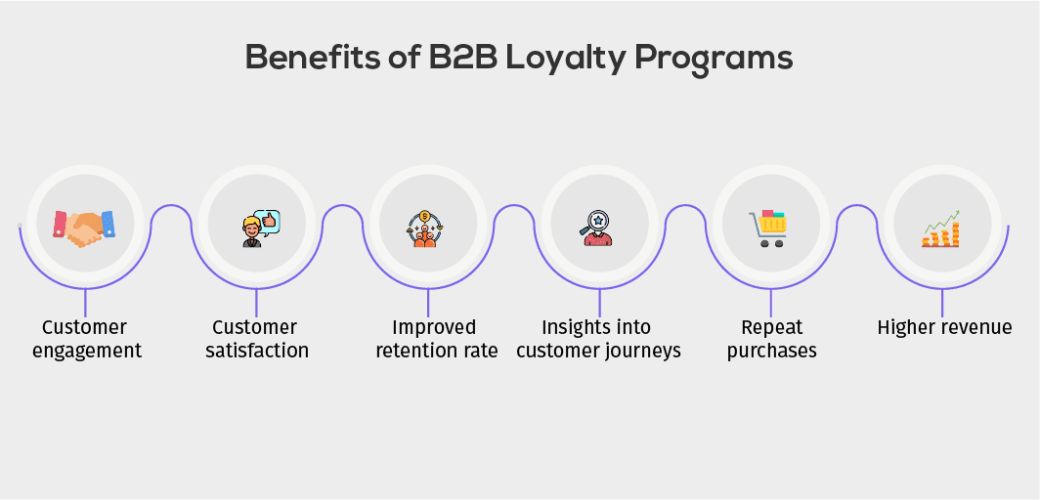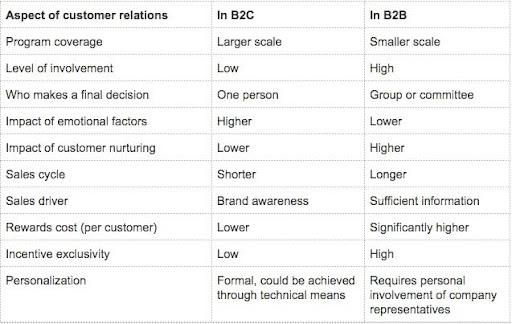B2B Loyalty Programs: Do They Work and How to Implement Them

B2B Loyalty Programs: Do They Work and How to Implement Them
This article explores how B2B loyalty programs work, their key models, and how you can implement them with the right approach.
What if your most loyal customers started buying from your competitors?
Unlike in B2C, where loyalty programs focus on individual perks, B2B loyalty programs are about strengthening long-term partnerships and driving repeat business. By rewarding companies for their ongoing engagement, you create stronger relationships, increase retention, and boost revenue.
Studies indicate that 84% of customers stick with a brand with an excellent loyalty program.
However, introducing B2B loyalty programs requires a strategic approach. In this article, we will discuss B2B loyalty programs and how to implement them.
What are B2B loyalty programs?
One way to retain long-term customers is by building a connection—and loyalty programs do just that.

B2B customers purchase in bulk, but not very frequently. Loyalty programs make them feel appreciated and keep them interested, driving long-term relationships. A good loyalty program can boost your revenue by 15 - 25% annually.
To make these programs effective, businesses must understand customer needs, preferences, and challenges, while also clearly outlining eligibility criteria, terms, and benefits.
The main objective is to improve customer experience and establish a company’s credibility in the market.
B2B loyalty programs typically function on four primary models:
- Point-based Rewards — Customers earn points for actions like purchasing, referring others, completing educational modules, or providing feedback. These points can be redeemed for discounts, free products, premium services, or exclusive perks—incentivizing continued engagement.
- Partnership Programs — These programs involve partnering for mutual growth. For example, a software development company could partner with a vendor to offer exclusive discounts on bundled solutions, which would benefit both parties and increase customer loyalty.
- Referral Programs — Referral programs turn satisfied customers into brand advocates. Businesses earn rewards—such as discounts, service credits, or special offers—for successfully referring new clients, reducing acquisition costs, and expanding reach organically.
- VIP Memberships — VIP programs offer priority service scheduling, access to special events, product releases, industry information, and educational content. These membership programs create greater levels of loyalty and make clients feel appreciated.
Yet, not all loyalty programs are equal.
What differentiates businesses is the kind of business you're in and the particular group of individuals you're focusing on to sell your products and services.
B2B vs. B2C Loyalty Programs
Although both B2B and B2C loyalty programs aim to retain and expand customers, the strategy is varied.

B2C loyalty programs target individual consumers by fostering emotional connections. They offer emotion-based rewards such as discounts, cashback, and customized benefits to drive repeat buying.
Indeed, 70% of B2C brands experience enhanced customer interaction through loyalty programs.
On the other hand, B2B loyalty programs are designed to improve business relationships by offering value-driven incentives such as business consultancy, strategic partnerships, and product trials to improve long-term engagement.
"The most successful B2B loyalty programs borrow key principles from credit card reward systems," says Gareth Boyd, Head of Growth at CreditCardCompare.com.au, a credit card comparison website. "If a loyalty program is to be successful, it must clearly communicate how rewards are earned, offer redemption options that align with business needs, and provide a return value that exceeds the perceived effort of participation. As tiered credit card programs create aspirational targets for consumers, effective B2B loyalty structures should include achievement levels that motivate increased engagement over time."
Some additional key differences include:
1. Decision-Making Process
- B2C: Individuals make decisions based on feelings, personal likes, and short-term satisfaction.
- B2B: Decisions are made with multiple stakeholders motivated by business value, ROI, and long-term strategic advantage.
2. Program Structure and Rewards
- B2C: Uses point-based, discounts, and short-term reward schemes to influence frequent buying.
- B2B: Focus on value-based incentives such as business consultancy, collaboration, and product trials to improve business operations.
3. Personalization
- B2C: The scope of personalization is limited due to a larger customer base.
- B2B: Due to a smaller customer base, programs are extremely personalized. The company focuses on unique business requirements and system improvement.
4. Membership Requirements
- B2C: Memberships are generally free and accessible to all consumers for delivering instant rewards.
- B2B: Clients must purchase or sign an agreement to join. The rewards are customized to business relationships and exclusive experiences.
5. Focus
- B2C: Focuses on mass acquisition, brand awareness, and repeat purchases through promotions and emotional connections.
- B2B: Given the lengthy sales cycle, businesses focus on generating hot leads that later turn into long-term customers—given the lengthy sales cycle. Programs are designed to benefit businesses and strengthen brand identity.
How to Build a Successful B2B Loyalty Program?
B2B loyalty programs tend to have lower but high-value customer bases, requiring personalization and thoughtful incentives to drive success.
Since B2B relationships are established on long-term value and trust, your loyalty program must align with industry needs and customer priorities.

With an effective B2B loyalty program, retention rates can increase to 76-81%, but it must be tailored, exclusive, and impactful for it to succeed.
The following are four main elements to concentrate on when developing a B2B loyalty program:
- Know Your Customer
- Determine the Incentive
- Simplify Onboarding System
- Measuring Performance and Optimize
- Localizing B2B Loyalty Programs for Global Audiences
1. Know Your Customer
Before designing a loyalty program, you must understand the following about your customers:
- Purchase patterns – How often do they buy? In what quantities?
- Pain points – What challenges do they face?
- Priorities – Are they focused on cost savings, efficiency, or innovation?
- Industry trends – What are their specific market needs?
After creating the buyer’s persona, you can build customized incentives and rewards that truly resonate with your customers and, in turn, increase your business's cash flow. Remember, businesses participate in a loyalty program only when they find relevant value drivers.
2. Determine the Incentive
B2B customers expect economic and operational benefits from loyalty programs. Offering relevant, high-value rewards increases participation and long-term commitment.
Effective B2B loyalty rewards include:
- Volume-based discounts – Encourages bulk purchases and repeat business
- Exclusive product trials – Provides early access to premium features
- Priority customer support – Helps build strong business relationships
- Invites to industry events – Offers networking and learning opportunities
- Personalized business insights – Shares data-driven recommendations
- Technology incentives – Providing free trials or discounts on essential business tools like accounting software.
Segmentation is key! Categorize businesses by size, industry, and location to offer rewards that align with their goals.
3. Simplify Onboarding System
A complicated onboarding experience can drive customers away—74% of customers abandon loyalty programs if the sign-up process is confusing.
Ensure that:
- The program’s objectives and benefits are clearly communicated.
- The enrollment process is simple and fast.
- Instructions for inactive members and re-engagement are provided.
- Terms and conditions are transparent to avoid misunderstandings.
A well-structured onboarding system builds trust and credibility, making participation effortless. Try using onboarding software to make it more efficient and easy.
4. Measuring Performance and Optimize
Introducing loyalty programs isn’t enough, and you must check their performance. This helps you identify gaps and modify the program to make it more effective. Measure the performance based on the following KPIs:
- Customer Lifetime Value (CLV)- Measures long-term revenue from loyal customers.
- Customer Retention Rate- Tracks how well the program retains businesses.
- Churn Rate- Identifies the percentage of customers leaving the program.
- Net Promoter Score (NPS)- Measures customer satisfaction and referral likelihood.
- Return on Investment (ROI)- Evaluate the financial success of the program.
5. Localizing B2B Loyalty Programs for Global Audiences
As businesses expand globally, localization is key in making loyalty programs more effective. Offering rewards, incentives, and communications in a customer’s preferred language and cultural context increases engagement and trust.
Using frameworks like Vue i18n, Angular i18n, and Next.js internationalization, businesses can create localized portals and dashboards that personalize loyalty experiences based on region, language, and market preferences. This ensures that:
- Reward structures align with regional business norms.
- Loyalty program interfaces and email notifications are available in multiple languages.
- Offers and incentives are tailored to country-specific regulations and preferences.
Localization, a key consideration for any B2B Consultant, ensures that B2B loyalty programs remain globally scalable while maintaining local relevance, ultimately strengthening long-term business relationships.
Mistakes to Avoid in Your B2B Loyalty Programs
Even a well-structured loyalty program can sometimes go wrong. To make your loyalty program thrive, you must avoid committing the following mistakes:
- Unclear Objectives
- Overcomplicated Enrollment Process
- Overwhelming Redemption Procedures
- Not Promoting the Program
- Focusing on Transactional Rewards
1. Unclear Objectives
Without clear goals, your loyalty program will be aimless, wasting resources and resulting in low customer engagement. If the program isn't aligned with your business objectives, it won’t deliver meaningful results.
Solution: Define your objectives clearly before starting to build the program. These objectives include customer retention, increasing repeat purchases, or improving partnerships. Also, regularly track and refine your program based on performance metrics to align it with business needs.
2. Overcomplicated Enrollment Process
A complex enrollment process discourages the customers from participating. Forms with too many data fields and lengthy verification procedures raise privacy concerns, leading to incomplete forms.
This is a major reason behind unsuccessful loyalty programs because the enrollment stage is the first step toward participation.
Solution: Reduce the fields in the enrollment form and eliminate unnecessary documentation. Request basic information such as "Name," "Phone Number," and "Email Address" to make the process simple by requesting basic information such as "Name", "Phone Number", and "Email Address." Additionally, consider integrating features that enhance user experience, such as instructions on how to forward a voicemail on iPhone, which can help customers feel more connected and engaged with your brand.
3. Overwhelming Redemption Procedures
Customers lose interest if earning and redeeming rewards feels like a complex, never-ending process. Limited redemption options and high reward thresholds make loyalty programs feel restrictive rather than rewarding.
Solution: Set smaller rewards to trigger motivation for achieving a milestone. Also, offer a diverse set of redemption options, such as product discounts, charitable donations, vouchers, and premium services.
4. Not Promoting the Program
Developing a loyalty program is not sufficient, and you need to market it. If the customers don't know about the program, they will not use it, which leads to lost opportunities and a low adoption rate.
Solution: You must invest your money, effort, and time equally in marketing the program. Use marketing and communication mediums such as newsletters, corporate websites, or email campaigns. Promote sign-ups by pointing out the rewards, features, and benefits.
5. Focusing on Transactional Rewards
Although transactional rewards are attractive in B2B loyalty programs, they don’t always appeal to customers. Primarily, loyalty programs are introduced to appreciate business relationships and foster trust.
Only transactional rewards won’t let you win the customer’s loyalty.
Solution: Include non-transactional rewards such as business consultancy, access to launch events, and potential business collaborations, along with transactional rewards. A mix of transactional and non-transactional rewards strengthens partnerships beyond transactions.
Building Trust, Not Just Rewards
B2B Loyalty Programs are not only about rewards. The primary goal of these programs is to build trust and honor long-term business relationships.
With the right approach and outsourcing virtual assistant services, these programs become effective and accomplish all business goals.
Moreover, implementing B2B loyalty programs directly impacts key KPI metrics that indicate a business's success. Therefore, every program component must be unique and designed to attract economic opportunities.
